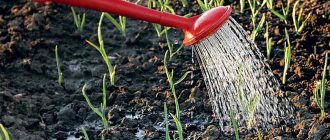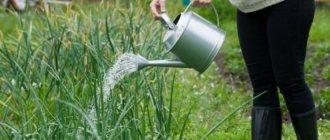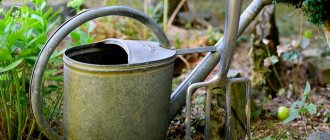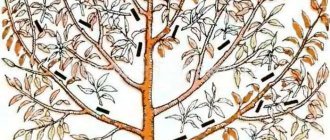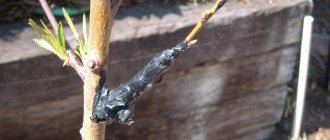October is an important month for winegrowers. At this time, several very important procedures must be carried out in the vineyard: treat the vine from diseases and pests, feed it, carry out pre-winter watering and pruning.
Before proceeding with the above work, you should restore order in the vineyard. First of all, remove all fallen leaves from under the grapes. It may contain spores of various diseases, in which case the fallen leaves will become a source of infection of the vines. After this, you can move on to other work. Let's tell you more about them.
Caring for grapes in September and October
Autumn care for grapes has two goals: to lay the foundation for high-quality fruiting in the next season and to prepare the plant for the winter period. A bush is considered fully ready for winter if it is healthy, not affected by pests or diseases, has well-ripened wood, has recovered the energy spent on fruiting, and has entered a dormant state in time.
These tasks and growing conditions determine how to care for grapes in the fall. List of main works:
- last feeding of the season;
- grape pruning;
- catarrh of roots;
- protection against fungi and insects;
- pre-winter watering;
- shelter for the winter.
The quality of autumn care is especially important for late grape varieties, which have limited time for wood to ripen and life processes to slow down. When grown in a temperate climate, even medium-ripening varieties may not have time to prepare for winter. In view of this, it is recommended to follow two rules:
- You need to start autumn work as early as possible - as soon as the harvest from the vines is harvested. The preparation of early varieties of grapes must begin without waiting for the end of fruiting of the entire plantation.
- Care should be taken in advance to ensure that the vines are not overloaded. If a plant spends too much energy on ripening the crop, it will be difficult to restore it in a short time. It is worth sacrificing the volume of the harvest in favor of the bush and normalizing it by thinning out the bunches.
Sheltering the vineyard for the winter
To cover the vineyard in winter, spruce branches are used, which are thrown over the vine bent to the ground. Agrofibre is thrown over the top, the edges of which are secured. The ends of the shelter are not closed - this ensures good ventilation, and the vine is protected from condensation and damping off. If you don’t have spruce branches at hand, you can cover the lashes with boxes and sprinkle dry leaves on top.
Sheltering grapes for the winter with agrofibre
For many northern regions, October is the month of completion of work on the vineyard, and further care of the bushes comes down to checking the shelter and retaining the snow around it.
Feeding grapes in autumn
A grape bush that is depleted of fruiting does not have sufficient resistance to cold and can freeze out during the winter. Conditions favorable for the development of fungi may form under the shelter (for example, due to thaws), and in this case, the health of the plants by spring will depend on their immunity, so sending weakened grapes to the shelter is dangerous.
To avoid negative consequences, the grapes must receive additional feeding in September.
It is necessary to replenish the supply of nutrients, primarily potassium and phosphorus, as well as calcium, magnesium, copper, iron, manganese, zinc and boron. During this period, it is not recommended to give nitrogen, since the substance provokes the growth of green mass, while the grapes should go into a dormant phase. Only young plants do not need feeding, since the fertilizers added to the hole when planting should be enough for 3-4 years. Important! Phosphorus and potassium promote the aging of wood.
Potassium, in addition, increases plant immunity and resistance to negative temperatures. Fertilizer can be applied in liquid form, dry method or by spraying. For watering, it is necessary to dig a 10 cm deep groove around the bush at a distance of 40 cm so that the fertilizer does not spread, wetting the surface layer of soil, but reaches the roots. As a liquid fertilizer in the fall, you should choose one of the following options:
- 30-40 g of superphosphate and 20-30 g of potassium sulfate per 10 liters of water;
- 20-40 g of potassium monophosphate for the same volume;
- extract from 200-300 g of wood ash per 1 liter.
Microelements can be added to the nutrient solution or applied foliar. Spraying should be carried out in the evening: at this time the absorbency of the leaves is higher than during the day, and there is no bright sun that can burn wet greenery. For foliar feeding, the concentration of the substance must be reduced by 3 times compared to the volume calculated for irrigation:
- magnesium sulfate – 1 g per 10 liters;
- manganese sulfate – 2 g;
- boric acid – 1-2 g;
- zinc sulfate – 2 g.
The bush will receive copper and iron in sufficient quantities if treatment with copper or iron sulfate is used as a preventive measure for fungal diseases. Additional spraying should not be carried out to avoid plant poisoning.
If a foliar method is used to feed microelements, phosphorus-potassium fertilizer can be given in dry form. To do this, it is enough to embed 300 g of ash into the soil when digging or put 10-15 kg of rotted manure or compost in a furrow 20-25 cm deep, dug around the bush, and then water the plant generously. The fertilizer ditch should be made at a distance of at least 40-50 cm from the growing point. You can also apply manure mixed with wood ash in the form of mulch. Only well-rotted organic matter is suitable for autumn feeding, otherwise the grapes will receive an excess amount of nitrogen.
When and how often to water grapes in spring, summer and autumn: rules and methods of watering
Obviously, for stable and abundant fruiting, grapes require a sufficient amount of nutrient moisture. This means that a novice winegrower faces a logical question: “How to water grapes in the summer during the growing season - when and how often to do it?”
Next, you will receive answers to all the basic questions regarding proper watering of grapes in summer, as well as in spring and autumn.
How to water grapes correctly
Basic rules of watering:
It is recommended to water with warm and settled water (it is very good to have a barrel or some kind of container in the sun at your dacha).
Watering with cold water is always stressful for the plant.
On the other hand, many experienced winegrowers water directly from a well (or from a water supply) with cold water and everything is fine...
By the way! But moisture-recharging autumn watering can be done with cold water from the tap.
It is very effective to combine watering grapes with feeding them (using organic and mineral fertilizers).
That is, you add fertilizers to the water for irrigation; what kind of fertilizers depends on the stage of development of the bush.
Water must necessarily reach the root layer, i.e. to a depth of 30-40 centimeters (this is the minimum, better - up to 40-60 cm).
Note! The main roots of grapes lie at a depth of 30-40 cm (the root heel of the bush), and the length (depth) of deep taproots can even reach several meters.
The frequency and specific volume of moisture required for watering grapes depends on many factors (climatic characteristics of the growing region, amount of precipitation, soil type, since sandy and sandy loam soils have to be watered twice as often, method of irrigation, depth of groundwater), which means that certain quantitative characteristics will be individual for each specific vineyard.
Important! You can’t water the grapes often and little by little, especially if you use surface watering. In this case, moisture does not enter the root layer; moreover, the top layer of soil becomes compacted and air permeability decreases, and without oxygen, the plant’s roots cannot breathe.
As a rule, 1 adult bush (per 1 square meter of feeding area) needs 40-60 liters in 2-4 weeks.
If the soil is clayey, then you should not water the grapes too often, especially if you have made a drainage well. Otherwise, a swamp will form there, the water will stagnate and the roots will rot.
Interesting! Why is it important to know what the depth of groundwater is in your area?
The fact is that thanks to a powerful, branched root system that penetrates deep underground, grapes are able to independently obtain the necessary moisture.
In fact, this is why grapes are able to survive in hot and dry growing regions.
However, it is worth understanding that stable and good fruiting and bush life on the brink of survival are not the same thing, because in the second case there can be no talk of abundant fruiting.
How to water grapes in the first year after planting
What needs to be taken into account during this period is that the young seedling has only managed to take root in a new place, but has not yet had time to grow a sufficient root system to independently obtain moisture at depth. This is why it is very important to water the grapes regularly after planting, especially in summer (June-July), i.e. during hot and dry periods.
The soil in the tree trunk circle should always be slightly moist.
But in August-September, watering the grapes must be stopped so that the vine has time to ripen well before wintering.
As a rule, young grapes are watered once every 1-2 weeks (in the absence of rain), while 10 to 20 liters of water are consumed per bush (depending on the degree of drying of the soil) and always in the holes made around the seedling.
Advice! It will be very good (preferably) if you periodically combine watering with fertilizing (for example, using the same solution of bird droppings or slurry).
When to water grapes: answers to frequently asked questions about watering
Watering of grapes is carried out throughout the growing season, depending on the needs of the plant during certain periods of growth and fruiting.
There are 3 main periods (not counting moisture recharges) when grapes require abundant watering:
At the moment the buds open and shoots begin to grow (2 weeks before flowering).
After flowering (after 1-2 weeks, when the ovary reaches the size of a pinhead, and then every 2 weeks).
During the period of intensive growth and filling of berries (before their coloring and, especially, the accumulation of sugar, technical maturity).
The last period is the most important, because it is due to moisture that the berries will fill.
Many novice winegrowers ask the same questions about the timing of watering grapes (by growing season), the most popular of them are collected below, and detailed answers are given.
How to water grapes in spring
If the groundwater under your vineyard is located deep enough and/or there was a dry, snowless winter, then in order to saturate the bushes with the necessary moisture to begin active sap flow in the shoots, you should carry out spring water-charging watering, naturally, having time to do this before the buds begin to open or after .
Water consumption during moisture-recharging irrigation of grapes in spring per 1 adult bush is from 50 to 100 liters.
Important! If you did autumn moisture-charging watering, then there is no need to do spring watering, especially if the winter was snowy and the soil was saturated with moisture. Otherwise (excess moisture) you will only harm your bushes.
Do grapes need to be watered during flowering?
No, it is recommended to water before (2 weeks) and after flowering (1-2 weeks, when the ovary reaches the size of a pinhead).
The fact is that watering grapes during the flowering period can lead to shedding of flowers and ovaries.
In other words, excess moisture during flowering causes peas and sparse bunches.
Is it necessary to water grapes at the beginning of ripening?
Let's assume that the berries on your grape bushes are already beginning to color, soften, in short, gradually ripen.
This is where disputes arise as to whether it is possible to continue watering the grapes during this period.
Opponents of watering argue that watering during this period will definitely have a negative impact on the berries: they may begin to “crack” and lose some of their sugars.
On the contrary, supporters of watering cite as an argument the fact that many varieties gain up to 40-50% of their mass during the period of color acquisition and before ripening. In addition, even if there are nutrients in the ground at this moment, without water they simply will not be able to get into the bush to improve the size and taste of your berries.
As for the frequency and rate of watering, you should not give the grapes an excessive amount of moisture during this period, in other words, watering should be reduced. So, for example, for an adult 5-year-old bush, 30-40 liters of water per week will be quite enough.
Of course, you should always look at the condition of the soil, and if it’s wet, don’t water it; if it’s dry, water it.
During this period, your main enemy is sudden rain, which can cause cracking of the berries.
Is it possible to water grapes after coloring the berries during the period of accumulation of sugars?
Another thing is when the berries are completely colored, gain mass, and the process of sugar accumulation begins in them, from this moment of the beginning of technical ripening all watering must be stopped.
Note! If this is not done, then with each watering you will simply reduce the amount of sugars in your berries; moreover, this will certainly lead to their cracking and a significant delay in ripening.
In addition, continued watering can negatively affect the condition and wintering of the bushes themselves, because excess moisture in the soil will stimulate growth processes in grape shoots, which in turn will delay their ripening and prepare the grapes for winter.
Do I need to water grapes in the fall?
There is no need to continue watering the grapes after fruiting. However, closer to mid-to-late autumn, it is worth performing autumn moisture-recharging watering after the leaves have fallen (in fact, it can be done earlier, when the leaves just begin to fall) and pruning the vines, but before sheltering for the winter.
The purpose of this watering is to saturate the root layer of the plant with moisture before wintering, due to which the soil will freeze less (in other words, the grape bushes will definitely not freeze, of course, if you cover them correctly for the winter, since moist soil has a higher heat capacity than dry.
By the way! If autumn is very rainy, then, of course, there is no point in doing moisture-charging irrigation.
Methods of watering grapes
Let's talk about the most popular and effective methods of watering grapes.
Surface watering
Most beginning, inexperienced summer residents use this particular type of irrigation, however, it is the most ineffective and unsafe (for grapes).
The fact is that the root system of grapes is not superficial, like most berry crops - currants, gooseberries, raspberries, especially strawberries, but deep.
In other words, due to shallow watering, the roots of the grapes will not deepen, which will negatively affect their wintering (the roots may simply freeze).
Accordingly, in order for nutrient moisture to reach the root layer, you will need a very large amount of moisture. It should be taken into account that a significant part will simply evaporate from the surface, and this in turn will increase air humidity, which can cause, or rather create, favorable conditions for the development of various fungal diseases.
However! This type of watering is suitable for 1-2 year old bushes, but for adults and fruit-bearing bushes it is necessary to organize a more correct method of delivering moisture to the root layer using one of the following methods.
Watering in grooves, trenches or holes
Along the rows of grape bushes, retreating from their base by 60-90 centimeters (in some sources it is recommended to retreat from the trunk up to 1 meter), grooves (pits or trenches) with a depth of 30-40 centimeters (one and a half shovels) are dug, or even better, 50- 60 cm.
Accordingly, you water (put a hose) into these depressions and the water almost immediately enters the root zone.
Idea! Or you can simply dig 4 holes around each bush (if there are not many bushes), pouring a bucket of water into each, but be sure to fill it up after the moisture is absorbed.
By the way! Some winegrowers, after each watering, bury (cover with earth) this groove to avoid the slightest evaporation of moisture (which is especially important in the summer, but this can be avoided in the spring and autumn).
Drip irrigation
Indeed, drip irrigation is perhaps the most modern and effective method of irrigation.
However! If you have a small vineyard, then there is no point in this, because... The equipment is by no means cheap.
Another thing is if you (in your region) have very hot and dry summers, little natural precipitation, or you have a large vineyard (more than 10-30 bushes), then drip irrigation is a completely reasonable solution to the problem.
Underground irrigation (through pipes and drainage wells) is the most popular and effective method for summer residents
How to organize underground watering of grapes through pipes:
at a distance of 50-60 centimeters from the base of the bush (in some sources it is recommended to retreat from the trunk to 1 meter), recesses are dug for the pipes (to a depth of at least 30-40 cm, and even better, 40-60 cm);
in the lower part of the pipe (lower 15-20 cm) holes are made around the circumference;
so that the pipe does not become clogged, then the lower holey part is wrapped in agrofibre and secured well (with tape and twine);
the pipe is inserted into a hole in the ground;
in this case, the upper edge of the pipe should protrude 15-20 centimeters above the ground (for ventilation).
Important! To prevent moisture from evaporating, be sure to cover the pipe with some kind of lid (plug).
Accordingly, watering the grapes is carried out directly into this pipe, thereby nutrient moisture reaches (is delivered) directly to the roots of the plant.
Video: pipe for watering grapes
An undeniable advantage! Thanks to underground irrigation, there is no need to loosen the soil, because... water does not reach the surface.
Or you can do not just watering through pipes, but watering through drainage holes (wells).
By the way! Irrigation through drainage wells is perfect for organizing the watering of individual bushes.
The principle of creating an underground drainage well for watering grapes:
Having retreated from the base by 50-60 centimeters (some sources recommend retreating from the standard up to 1 meter), dig a hole - 40-60 in depth and 40-60 in diameter (on average - 50 by 50 cm);
pour a little humus on the bottom (it will be used as a long-term fertilizer);
then lay a 15-20 centimeter drainage layer of crushed stone (preferably expanded clay crushed stone);
Worth knowing! 30-40 liters of crushed stone volume (“drainage”) are freely simultaneously filled with 10-20 liters of water.
directly into the crushed stone, halfway up its layer (maybe a little deeper), insert the end of the filler pipe;
then cover with plastic film, roofing felt or pieces of linoleum (to prevent silting of crushed stone) and cover with earth.
It’s even better to pour a 10 cm layer of gravel or sand on top of the crushed stone layer and around the pipe, and sand is better, because it will not only protect the crushed stone from silting, but will also allow free growth of roots.
By the way! As a rule, plastic or asbestos-cement pipes with a diameter of 50 to 100 mm are used as irrigation pipes.
The essence of watering remains the same (water immediately enters the root layer), only in this case you fill your drainage well with water (until it begins to flow out), while the moisture lasts longer and is consumed gradually.
Important! To prevent moisture from evaporating, be sure to cover the pipe with some kind of lid (plug).
Idea! You can not just bury pipes vertically, but make a mini-water pipeline by laying it horizontally. To do this, you need to dig a ditch along the entire length of the row spacing, into which you then lay a leaky pipe (both ends of the pipe need to be brought to the surface), of course, first drilling several holes in it (with a diameter of 5-7 mm approximately every 10-15 cm) circumference of the entire length of the pipe so that the water well saturates the soil in the root layer.
Thanks to this method, roots will grow not only next to the drainage well, but along the entire length of the trench.
By the way! There is a temporary and simpler solution for underground watering (similar to homemade drip irrigation for vegetables): you can simply dig 5-liter bottles into the ground and water through them, first cutting off the bottom.
Or you can make underground watering of grapes more stationary (with drainage), using the idea from the following video:
Thus, now you know how to water grapes correctly, when and how often to do it, as well as what watering methods exist, which means that big harvests are just around the corner. Good luck, aspiring winegrowers!
summer cottage tipsharvestsoilcottage shrubsgardeningberriesfruits
Share link:
Winter pruning of grapes
The key point in caring for grapes in the fall is pruning for the winter; its task is to rejuvenate the bush to maintain high yields, clear damaged areas and thin out shoots, reducing the risk of diseases. It is optimal to carry out the procedure in two passes.
Pre-cut
It is carried out in September, when the bushes still have leaf cover. Instructions for the first autumn pruning look like this:
- Damaged and dry vines should be removed.
- Cut off growth from the main trunks that has reached 60 cm in height.
- Shoots that have grown above 30 cm from the ground should be shortened by 15% of their length.
- Trim the stepsons to 2 leaves.
The cut areas must be treated with 3% hydrogen peroxide or a strong solution of potassium permanganate (concentration about 50 g per 1 liter of water). After the cuts have dried, cover them with garden varnish.
Basic trimming
The procedure must be performed 2-3 weeks after the leaves fall, when the movement of juices in the vines has already stopped, but before serious frosts.
Attention!
If you perform the main pruning ahead of schedule, it will be difficult for the grape bush to stockpile nutrients - this requires green mass, the volume of which determines the rate of photosynthesis processes. If done too late, allowing the vines to freeze, their wood will become brittle and may crack when cut.
Sequence of pruning actions:
- On last year's replacement branch, you need to remove the vine that bears fruit this season, cutting it as low as possible.
- The shoot from the outside (bottom) of the fruit link should be shortened to the level of 3 buds - a new replacement knot will be formed from it.
- Of the shoots on the inside, 1-2 should be left on the fruit shoot, trimmed to about 6-10 buds. The exact number of eyes that need to be left can be determined by the diameter of the shoot, adding 1 or 2 to its value, and for varieties with small clusters (less than 0.5 kg) - 3-5. The resulting number will be the “number” of the eye on the fruit arrow, above which the cut should be made.
- All stumps must be treated according to the standard procedure: first with potassium permanganate or peroxide, and then with garden varnish.
The principle of this pruning is the constant renewal of shoots on the bush, in which no branches older than 4 years remain. This allows three-year-old vines, which are at the peak of their fertility, to receive maximum nutrition.
Catarovka roots
Simultaneously with preliminary pruning of the bush (in September), root pruning, called catarrh, can also be carried out. Small (dew) roots located in the upper layers of the soil must be removed. It is this part of the root system that primarily suffers from soil freezing in winter or drying out in dry summers and is the least resistant to damage by grape soil aphids. Rotting of small roots can spread to the main root.
Catarovka is required if it is not possible to regularly care for the grapes. If the bush is provided with constant supervision, the roots can be removed at will as a safety net.
Catarosis procedure:
- Loosen and remove a 20 cm thick layer of soil from the tree trunk circle.
- Cut off the dew roots near the trunk, leaving no stumps.
- If the plant is mature, thickened roots may also be located in this layer. Their pruning should be carried out gradually over 2-3 years, that is, 30-40% of the shoots need to be removed at a time.
- Disinfect the cut areas with a solution of copper sulfate (3%) or boric acid (1%).
- Let it dry.
- If desired, you can wrap the root with film, but do not tighten it tightly. Admission will allow you to delay the next catarrh procedure for 2-3 years.
- Return the soil to the tree trunk circle.
How to water in the first year
After planting and before the end of the first year of growing season, it is important that the plant takes root and grows the root system in depth, and not in the surface layer of soil. To do this, the bushes are heavily fertilized - preferably with organic matter - and watered more often. It is too early to worry about the quality of the berries; it is important to form the plant’s immune system.
How often to water grapes after planting depends on summer temperatures. How does the boarding procedure work:
- 50–70 cm deep is dug
- Hot water is poured in to warm the soil in the spring. If you plant in the fall, then pour regular water.
- After planting the seedling, the hole is half covered with earth. Water again - this time with warm liquid. You can sprinkle fertilizer around the shoot - rotted manure or one of the complex mixtures, for example, Kemira. The soil should be compacted by the action of water.
- Completely fill the hole and cover the seedling with a cut-off plastic bottle so as not to “go blind” under the strong spring sun.
Throughout the summer, it is necessary to apply liquid within the planting hole - no further than 25 cm from the shoot.
Watering continues until the beginning of August. Then it is stopped to speed up the maturation of the roots. It must be remembered that excess moisture for grapes threatens disease due to poor absorption of nutrients and lack of oxygen in the soil.
Disease and pest control
Treatment of the bush against pests and diseases should be carried out immediately after harvesting. It is necessary to stop the spread of insects or fungi on the grapevine as quickly as possible - this will increase the chances that damaged plants will have time to recover before winter. In addition, by winter, many pests turn into larvae, becoming invulnerable to some drugs.
In the case of autumn processing, the use of “chemistry” is justified, safe for the next year’s harvest, but more effective than biological and folk remedies.
- Depending on the type of pest, insecticides and acaricides should be used - “Aktellik”, “Oxychom”, “Dimethoate” and others.
- Against the fungus, you need to treat with 5% iron sulfate, and in October, after the leaves have fallen and pruned, spray with a 3% solution of copper sulfate.
- In addition to these measures, you can use biological products (Fitosporin, Glyokladin, Gamair, Trichodermin), but you should pay attention to the air temperature necessary to maintain the working properties of the product.
Healthy!
It is permissible to add urea to iron sulfate. A concentration of 1-2% of the substance in the spray solution is enough to destroy insect larvae (the product affects the external integument of insects).
If the treatment is preventive in nature, the following scheme is recommended:
- After harvesting, treat pests with lime mortar. To do this, pour 1 kg of quicklime into 3 liters of water and, after waiting for the reaction to complete, pour 7 liters of water into the solution.
- After the leaves fall, dig deep into the soil to destroy the mycelium and destroy the larvae overwintering in the soil.
- In the first half of October, spray with a solution of 10 tablespoons of salt and 5 tablespoons of soda per bucket of water.
- After pruning, bend the vines to the ground, preparing them for shelter.
- Shortly before insulating the bush for the winter, spray with 3% iron sulfate.
In this case, in the spring, after cleaning the shelter, it is necessary to treat the bushes with a 1% solution of copper sulfate. We should not forget that it is necessary to spray not only the vine, but also the soil in the tree trunk circle.
Pre-winter watering
Autumn care for grapes in September in the middle zone involves continuing watering as usual, with the exception of periods of rainy weather. Moisture deficiency prevents wood from preparing for the winter season.
It is especially important to maintain moisture if the grapes grow on sandy or sandy loam soil. In this case, you need to water the vineyard often, in small portions, but plants on clay soil or black soil need less frequent but abundant irrigation.
After the leaves have fallen off and the main pruning has been carried out, but before the soil has time to freeze, you need to do water-recharging watering. Water should be poured into trenches 10 cm deep around the bush. On average, you need to give 5 full buckets of water for each plant. Old and growing vines will need up to 10 buckets, young plants will need 10-30 liters. Sandy soil requires an increase in the watering dose to 6 buckets (relative to the average), and clay soil reduces it to 2.5-3 buckets.
How to determine moisture deficiency or excess
If the ground is very wet, the following signs can be observed:
- shoots grow quickly;
- after pruning, new stepsons appear within a month, which take a lot of energy and nutrients from the bush, not leaving it for the formation of brushes;
- the growth and filling of berries, and subsequently their ripening, is suspended;
- supposedly ripe berries taste very sour, although they do not differ in color from ripe ones.
The vine formed last year does not ripen and does not become woody.
If the clusters are not dense, the berries are smaller than expected according to the characteristics of the variety, and new shoots grow poorly in the spring, then there is a moisture deficiency in the soil. This occurs if there was little snow in winter and no autumn watering was carried out.
Video: Watering grapes - how to do it right
Sheltering the vines for winter
The grapes need to be covered until the temperature reaches -5°C. The vine should be bent to the ground even earlier in order to catch it before the first frost. Frozen wood loses its flexibility, so the vine may crack during installation.
If overheated, the root system of the bushes may dry out. It is advisable to first make a light cover and later strengthen it; another option is to remove the cover during periods of autumn warming. In regions with snowless winters, denser cover is required, but the material must be breathable - lack of ventilation will cause condensation to form, which can lead to the appearance of fungi and mold.
Covering an adult bush
The vines need to be untied from the supports and bent to the ground, preferably secured with hooks. They should be covered from above with spruce or pine branches. Spruce branches are considered the best cover for grapes, since they retain a layer of snow and do not interfere with air access to the vine.
Advice!
During periods of severe frost, you can put a tarpaulin and even film on top of the branches, but you must leave holes for ventilation.
Sheltering seedlings and plants of the first year
Bushes planted last spring or on the eve of winter need to be insulated more carefully - it is recommended to bury the shoots. To do this, furrows about 30 cm deep should be dug around the bush. The shoots, previously tied, should be carefully placed in a trench, being careful not to damage them, and covered on top with three layers (about 10 cm each): soil, humus and another layer of soil.
Special techniques for preparing grapes for winter
Ripening is facilitated by curling the shoots into a ring, reflective screens, and temporary autumn shelter for horizontally laid and not yet pruned vines.
Take your time with pruning and covering. For a good wintering, the shoots must undergo hardening. The first frosts will damage the green leaves and shoots, but will only harden the vine. There is also an old trick for “explaining” to grapes that winter is coming. With a sharp blow of a metal scrap, break the integrity of the soil coma and surface roots 15–20 cm from the head of the bush.
Problems of autumn care
The main trouble with grapes during autumn preparation, which can happen even if all care points are followed, is a slowdown in the ripening process of the wood. Gardeners usually discover the problem in October, when it is time to prune the plant and the bush is still green. In this case, you can help matters by accelerating ripening artificially. It is necessary to lay the vine on the ground and cover it with material with good thermal insulation qualities. After the wood has ripened, the bush should be freed from the shelter, the necessary manipulations should be carried out (pruning, preventative treatment, pre-winter watering) and covered as planned for the winter.
It is advisable to take care of stimulating the aging of wood in advance. In addition to shelter in October, two techniques will help:
- At the end of August and beginning of September, you should stop watering the grapes. If the weather is hot enough that the plant would suffer without irrigation, moisture can be given along with a root feeding of potassium and phosphorus.
- In September, you need to carry out unscheduled spraying with fertilizer containing potassium and phosphorus (20-30 g of each substance per 10 liters).
Preparation for winter carried out in the fall, no less than spring work and care during the season, determines the future volume and quality of the grape harvest. Plants that successfully survive the winter grow quickly, suffer less from diseases and have sufficient strength to grow fruit.
Autumn watering
Regardless of whether the grapes are old or young, care in the fall and preparation for winter first of all requires moisture-replenishing watering. While the berries are still hanging on the vine, it is impossible to overfill the crop with water. Excess moisture will cause the berries to crack. Wasps, bees, small flies will flock to the sweet juice and the harvest will be spoiled.
Watering grapes begins in the fall after harvesting the berries. There is no need to water the bushes often, but the soil should be kept moist. The roots need nourishment after harvesting. Winegrowers determine the amount and intensity of watering intuitively, based on the weather, soil conditions, and the depth of underground water layers. Despite all the nuances, in October the vineyard must be generously flooded with water once. To ensure that moisture penetrates precisely to the roots, grooves are dug in the ground around the bush or holes are drilled with a drill.
Important! The soil, saturated with moisture since autumn, freezes less in winter during severe frosts, which is beneficial for the root system.
You need to care for grapes wisely, that is, don’t just pour water under the bush. First, the composition of the soil is taken into account. Loose soil and sandstones absorb a lot of moisture and do not retain it. On such soil, a grape bush is filled with 60 liters of water. Heavy soil with admixtures of clay or black soil does not allow moisture to pass through well and retains it. Caring for a vineyard in such a plot comes down to minimal watering. It is enough to pour 25 liters of water under the bush.
Attention! If an irrigation pipe is buried under a grape bush, the water rate is reduced. This is due to the fact that the entire soil will not be moistened. Water poured into the pipe immediately penetrates the root system.
In the video, grapes, care in the fall, methods of water-charging irrigation:
